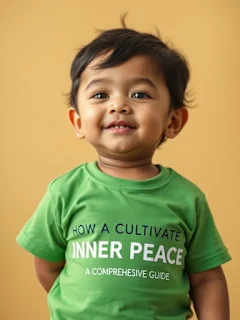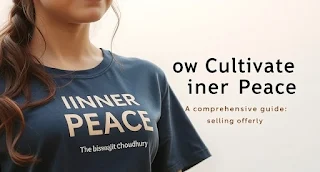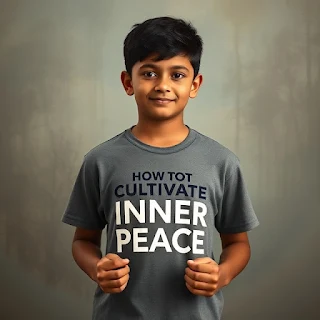How to Cultivate Inner Peace: A Comprehensive Guide

How to Cultivate Inner Peace: A Comprehensive Guide
What Is Inner Peace? A Beginner’s Introduction
Inner peace is often described as a state of mental and emotional calmness that persists despite life's challenges. For beginners, think of it as a balanced mindset where negative emotions don’t overwhelm you. It’s not about eliminating stress but learning to handle it gracefully.
The Connection Between Physical Health and Inner Peace
Your physical well-being plays a significant role in achieving inner calm. Regular exercise, proper sleep, and a balanced diet reduce stress hormones and support a peaceful state of mind. Simple habits like stretching or walking can anchor your mind and body in harmony.
Scientific Insights: Why Inner Peace Matters
Research shows that practices like mindfulness can lower cortisol levels, the primary stress hormone, and increase grey matter in the brain, enhancing emotional regulation. These scientific findings emphasize that inner peace is not just a mental luxury but a vital aspect of overall health.
Daily Habits to Build Inner Peace
Inner peace isn’t achieved overnight; it’s cultivated through consistent daily actions. Consider integrating these habits:
- Start your day with 5 minutes of deep breathing.
- Journal your thoughts and emotions to declutter your mind.
- Spend time in nature, even if it’s just a short walk.
- Set boundaries to protect your energy and time.
Visualization Techniques for Inner Peace
Visualization is a powerful tool to calm the mind. Imagine yourself in a peaceful place, such as a serene beach or a lush forest. Close your eyes and focus on the sights, sounds, and smells of this location. This creative exercise trains your brain to find calmness, even in chaotic moments.
Conclusion and Next Steps
Inner peace is a journey that requires patience and intentionality. By addressing both mental and physical aspects of your well-being, and incorporating scientific and creative practices, you can create a life of balance and fulfillment. Start with small, consistent habits and grow from there.
Take Action Today
Download our Free Inner Peace Toolkit and discover actionable tips to build a more balanced life. Share your journey with us in the comments!
How to Cultivate Inner Peace: A Comprehensive Guide
Introduction
In a world filled with constant demands, distractions, and pressures, cultivating inner peace has become a necessity for mental and emotional well-being. Inner peace is more than the absence of stress; it's about achieving a state of balance, calm, and resilience in the face of challenges. This blog will delve into practical steps, common pitfalls, and actionable strategies to help you embark on your journey toward lasting tranquility.
By the end of this article, you'll understand the essence of inner peace, its benefits, and how to integrate it into your daily life.
Understanding Inner Peace
Inner peace refers to a state of mental and emotional harmony where external circumstances no longer dictate your internal calm. It’s not about avoiding stress or difficulties but about responding to them with grace and balance.
- Self-Awareness: A key component of inner peace is understanding your emotions and reactions.
- Acceptance: Embracing the present moment, even when it’s not ideal, fosters a peaceful mindset.
Key Takeaway: Inner peace stems from within and grows with practice and self-awareness.
Benefits of Cultivating Inner Peace
- Stress Reduction: Inner peace equips you to handle stress without being overwhelmed.
- Improved Mental Health: Helps alleviate anxiety, depression, and emotional instability.
- Stronger Relationships: Promotes empathy, patience, and effective communication.
- Enhanced Focus: A calm mind can concentrate better, boosting productivity.
Steps to Cultivate Inner Peace
1. Practice Mindfulness
Mindfulness involves focusing your attention on the present moment. Activities like meditation, deep breathing, and mindful walking can help you stay grounded and centered.
Tip: Start with five minutes of deep breathing each morning to set a peaceful tone for the day.
2. Embrace Gratitude
Gratitude shifts your focus from what’s lacking to what you have. Regularly expressing thanks can improve your mood and outlook.
3. Let Go of Control
Accepting that you can’t control everything is a powerful step toward inner peace. Focus on what you can influence and release the rest.
4. Build Emotional Resilience
Learn to manage your emotions effectively. Practices like journaling, talking to a trusted friend, or seeking professional help can help you process feelings constructively.
Common Pitfalls to Avoid
- Seeking Perfection: Inner peace doesn’t mean a stress-free life. Avoid setting unrealistic expectations for tranquility.
- Neglecting Self-Care: Peace starts with taking care of yourself physically and emotionally.
- Overcommitting: Spreading yourself too thin can disrupt your sense of balance.
Comparison Table: Techniques to Cultivate Inner Peace
| Technique | Purpose | Benefits |
|---|---|---|
| Mindfulness | Focus on the present | Reduces stress and increases self-awareness |
| Gratitude Practice | Shift focus to positivity | Improves mood and emotional health |
| Journaling | Process emotions | Provides clarity and emotional relief |
FAQs
1. How long does it take to cultivate inner peace?
Inner peace is a journey, not a destination. With consistent practice, many individuals notice significant improvements within a few weeks.
2. Can inner peace help with anxiety?
Yes, practices like mindfulness and gratitude can reduce anxiety by promoting a calm and balanced mindset.
Conclusion and Takeaways
Inner peace is an essential foundation for a fulfilling and balanced life. By practicing mindfulness, building emotional resilience, and embracing gratitude, you can transform your mental and emotional well-being. Remember, it’s a process that requires patience and dedication.
Take Action: Start your inner peace journey today by incorporating one mindfulness practice into your routine.
Call-to-Action
Ready to transform your life? Download our Free Inner Peace Toolkit and begin your journey toward balance and tranquility. Share your progress in the comments below!











Comments
Post a Comment